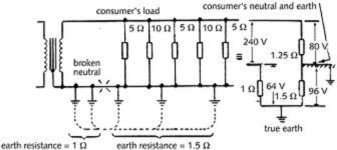Sorry to divert this thread, but help me out here. If the backhoe severed only the neutral leg, then how would 240 v get to 120 v appliances? Aren't those appliances powered by one leg of the 240, and the return is the neutral? So you might have 120 v on one side of your outlet, but the other half would be dead and nothing works. Correct?
I posted this a few years back about what happens when a neutral goes "open". Hopefully this diagram will help people visualize what goes on.
For
purposes of clarification, we'll leave the earth ground out of the picture. Once the neutral opens, the first load when turned on won't work and every load
on that same hot leg will also not work. As soon as a load on the other hot leg is turned on, you have created and completed a series circuit. As you turn on more and more individual loads, you create a complex series and parallel load situation so again
for purposes of clarification lets consider just two loads, one on each hot leg. The thing is, with a series connection, the current flowing through every load is exactly the same. Has to be.
As you see in the example, with a load on each hotleg, the open neutral suddenly places those two loads in series. What we want to calculate is the voltage potential (voltage drop) across each load. Another given is, the total of all the voltage drops across all the loads adds up to the total applied voltage. Has to be. In an open neutral situation, that would be 240 volts.
Volts (voltage drop) equals amps times resistance. Again,
for purposes of clarification lets assume the resistance of each load remains the same with respect to what it was in a normal situation, (in real life it may or may not but for our purposes here, it doesn't matter) Going back to our power equation, you can calculate the voltage drop across each load. In a normal situation, each load sees only that current flow allowed by the resistance of the individual loads, and the voltage remains constant. In an open neutral situation, the current flow through every load is the same and the individual voltage drops across each load are what fluctuates.
As you can see, the loads with the higher resistance are the ones that see the higher voltage drop across them and vice versa. This also means that if both loads have exactly the same resistance, everything will appear to be normal. It also means that as more and more loads with different resistances are turned on, the voltage drop across every one of them will change, but the total of all of them must still add up to the applied voltage - 240 volts - but each individual load sees a different voltage drop across it.


